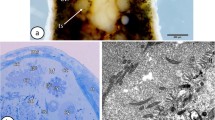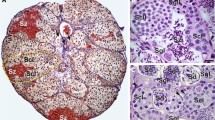Summary
At the microscopic level, the action of methyl testosterone on the cells of the kidney of the female three-spined Stickleback gives raise to a cytodifferentiation which leads to the formation of mucous glandular cells. This action is evident at two different levels:
At the level of the proximal tubule, the first visible sign of cytodifferentiation is an activation of the nucleolus, accompanied by a growth of the cell size. Then a rapid development of the ergastoplasm and the Golgi apparatus takes place, which leads to the elaboration of two types of secretory particles: granules of 2000–2500 Å in diameter appear first, then typical mucigen granules become visible. These latter undergo a rapid mucous transformation.
A regressive cytodifferentiation occurs at the same time. It concerns the apical pinocytosis which disappears in the cells undergoing the glandular differentiation.
At the level of the collecting tubules, the cytodifferentiation is characterized by the elaboration of a clear mucus which originates in the Golgi apparatus and migrates to the apex of the cells. A disappearance of the pinocytosis is also noticeable.
In the kidney of the female, methyl testosterone induces a cytodifferentiation which is identical to that occuring in the male during the breeding period. So the mucous transformation of renal cells is under the control of a single hormone: the testosterone, which is able to give raise to a succession of phenomena leading to the formation of a mucous secretion.
With the electron microscope, it is possible to demonstrate that three days are necessary for the elaboration of the mucus ready to be discharged in the lumen of the renal proximal tubules. In the collecting tubules, the reaction occurs more quickly, after only two days of treatment.
Résumé
Au microscope électronique, l'action de la méthyltestostérone sur les cellules rénales de l'Epinoche femelle se traduit par une cytodifférenciation conduisant à la formation de cellules glandulaires muqueuses. Elle a lieu simultanément à deux niveaux distincts:
Au niveau du tubule proximal, le premier signe visible de cytodifférenciation est une activation du nucléole, accompagnée par une augmentation de taille des cellules. Puis on assiste à un développement de l'ergastoplasme et de l'appareil de Golgi et à l'élaboration de deux types de sécrétions: d'abord des granules de 2000–2500 Å, ensuite des grains de mucigène typiques, qui subissent rapidement une transformation muqueuse.
Une cytodifférenciation régressive intervient en même temps. Elle concerne la pinocytose apicale qui disparaît.
Au niveau des tubules collecteurs, la cytodifférenciation se traduit par la formation d'un mucus hyalin d'origine golgienne. Elle s'accompagne également d'une disparition de la pinocytose.
La méthyltestostérone est capable de provoquer, chez la femelle, une cytodifférenciation rénale identique à celle que l'on observe chez le mâle pendant la période de reproduction. La transformation muqueuse des cellules rénales est donc sous le contrôle de la seule testostérone, qui déclenche au niveau cellulaire un ensemble de processus conduisant à la formation de mucus.
Au microscope électronique, on constate que l'élaboration de mucus prêt à l'excrétion est achevée au bout de trois jours dans les tubules proximaux alors que dans les tubules collecteurs elle ne demande que 24 heures.
Similar content being viewed by others
Bibliographie
Ahsan, S. N., Hoar, W. S.: Some effects of gonadotropic hormones on the three-spined Stickleback, Gasterosteus aculeatus. Canad. J. Zool. 41, 1045–1053 (1963).
Biswas, N. M., Deb, C.: Effect of hypophysectomy, castration and testosterone propionate on the kidney of the Toad (Bufo melanostictus). Acta histochem. (Jena) 31, 215–218 (1968).
Borcea, I.: Quelques observations sur une Epinoche, Gasterosteus aculeatus, provenant d'une rivière se déversant au fond de la baie Aber, près du laboratoire de Roscoff. Bull. Soc. Zool. France 29, 140–141 (1904).
Courrier, R.: Etude préliminaire du déterminisme des caractères sexuels secondaires chez les Poissons. Arch. Anat. (Strasbourg) 1, 118–144 (1922).
—: Les caractères sexuels secondaires et le cycle testiculaire chez l'Epinoche. Arch. Anat. (Strasbourg) 4, 471–476 (1925).
Cox, R. F., Sauerwein, H.: Studies on the mode of action of progesterone on Chicken oviduct epithelium. I. Morphological changes associated with early differentiation of the tissue. Exp. Cell Res. 61, 79–90 (1970).
Craig-Bennett, A.: The reproductive cycle of the three-spined Stickleback, Gasterosteus aculeatus L. Linn. Phil. Trans. roy. Soc. B 219, 197–279 (1931).
Dahnke, H. G., Mosebach, K. O.: Kombinierte elektronenmikroskopische und biochemische Untersuchungen über den Einfluß von Testosteron auf das Vesikulardrüsenepithel junger Ratten. Acta endocr. (Kbh.) 64, 519–530 (1970).
Dalton, A. J.: A chrome-osmium fixative for electron microscopy. Anat. Rec. 121, 281 (1955).
Ericson, L. E., Melander, A., Owman, C., Sundler, F.: Endocytosis of thyroglobulin and release of thyroid hormone in mice by catecholamines and 5-hydroxytryptamine. Endocrinology 87, 915–923 (1970).
Freeman, J., Spurlock, B.: A new epoxy embedment for electron microscopy. J. Cell Biol. 13, 437–443 (1962).
Hess, W. N.: A seasonal study of the kidney of the five-spined Stickleback, Eucalia inconstans cayuga Jordan. Anat. Rec. 14, 141–163 (1918).
Hoar, W. S.: Hormones and the reproductive behaviour of the male three-spined Stickleback (Gasterosteus aculeatus). Anim. Behav. 10, 247–266 (1962).
Ikeda, K.: Effects of castration on the secondary sexual characters of anadromous Stickleback, Gasterosteus aculeatus aculeatus L. Japan. J. Zool. 5, 135–157 (1933).
Kohler, P. O., Grimley, P. M., O'Malley, B. W.: Estrogen-induced cytodifferentiation of the ovalbumin-secreting glands of the Chick oviduct. J. Cell Biol. 40, 8–27 (1969).
Liao, S., Stumpf, W. E.: Autoradiographic evidence for the selective enhancement of nucleolar ribonucleic acid synthesis in prostatic nuclei by testosterone. Endocrinology 83, 629–632 (1968).
Möbius, K.: Über die Eigenschaften und den Ursprung der Schleimfäden des Seestichlingsnestes. Arch. mikr. Anat. 25, 554–563 (1885).
Mourier, J.-P.: Structure fine du rein de l'Epinoche (Gasterosteus aculeatus L.) au cours de sa transformation muqueuse. Z. Zellforsch. 106, 232–250 (1970).
- Résultats non publiés (1971).
Nutt, S. Mc., Weinstein, R. S.: The ultrastructure of the nexus. A correlated thin-section and freeze-cleave study. J. Cell Biol. 47, 666–688 (1970).
Oordt, G. J. Van: Secondary sex characters and testis of the ten-spined Stickleback (Gasterosteus pungitius L.). Proc. kon. ned. Akad. Wet. Amst., Sec. of Sci. 26, 309–314 (1923).
—: Die Veränderungen des Hodens während des Auftretens der Sekundären Geschlechtsmerkmale bei Fischen. I. Gasterosteus pungitius L. Arch. mikr. Anat. 102, 379–405 (1924).
Prasad, M. R. N., Sanyal, M. K.: Effect of sex hormones on the sexual segment of kidney and other accessory reproductive organs in the Indian house Lizard, Hemidactylus flaviviridis R. Gen. comp. Endocr. 12, 110–118 (1969).
Reddy, P. R. K., Prasad, M. R. N.: Hormonal control of the maintainance of spermatogenesis and sexual segment in the Indian house Lizard Hemidactylus flaviviridis Rüppell. Gen. comp. Endocr. 14, 15–24 (1970).
Sanyal, M. K., Prasad, M. R. N.: Sexual segment of the kidney of the Indian house Lizard, Hemidactylus flaviviridis Rüppell. J. Morph. 118, 511–528 (1966).
Sar, M., Liao, S., Stumpf, W. E.: Nuclear concentration of androgens in Rat seminal vesicles and prostate demonstrated by dry-mount autoradiography. Endocrinology 85, 1008–1011 (1970).
Titschack, E.: Die sekundären Geschlechtsmerkmale von Gasterosteus aculeatus L. Zool. Jb., Abt. allg. Zool. u. Physiol. 39, 83–147 (1922).
Trump, B. F., Smuckler, E. A., Benditt, E. P.: A method for staining epoxy sections for light microscopy. J. Ultrastruct. Res. 5, 343–348 (1961).
Tveter, K. J.: An autoradiographic study on the localization of androgen in the prostate gland and the seminal vesicles of the male Rat. Acta endocr. (Kbh.) 63, 207–215 (1970).
Venable, J. H., Coggeshall, R.: A simplified lead citrate stain for use in electron microscopy. J. Cell Biol. 25, 407–408 (1965).
Wai, E. H., Hoar, W. S.: The secondary sex characters and reproductive behaviour of gonadectomized Sticklebacks treated with methyl testosterone. Canad. J. Zool. 41, 611–628 (1963).
Author information
Authors and Affiliations
Additional information
L'auteur tient à remercier Monsieur le Professeur E. Follénius pour ses conseils et son aide précieuse au cours de la réalisation de ce travail.
Rights and permissions
About this article
Cite this article
Mourier, J.P. Étude de la cytodifférenciation du rein de l'Epinoche femelle après traitement par la méthyltestostérone. Z.Zellforsch 123, 96–111 (1972). https://doi.org/10.1007/BF00337676
Received:
Issue Date:
DOI: https://doi.org/10.1007/BF00337676




